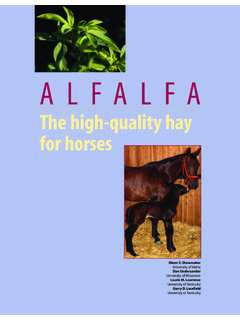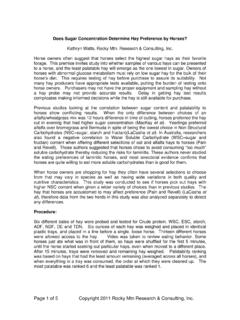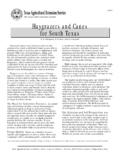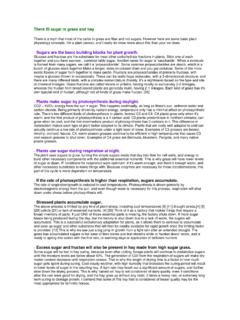Transcription of FEEDING THE HOOF - naturalhorsetrim.com
1 2008 Eleanor M. Kellon, VMD. FEEDING THE HOOF. Eleanor M. Kellon, Equine Nutritional Solutions Ephrata, Pennsylvania USA. Much of the information below is extracted from materials in either my Nutrition as Therapy or Cushing's and Insulin Resistance courses. Before getting to that, I just want to mention that FEEDING for hoof health is no different that FEEDING for health in general. There are no magical nutrients for hoof health. Every cell in the horse's body is like a tiny battery powered factory. Like all batteries it depends on a very specific balance of ions (minerals) to operate. The factory is fueled by calories in the form of carbohydrates, fats, protein and fermentation products from the hindgut and it uses these to manufacture the products it needs enzymes, membranes, proteins of many types. Horses are able to interconvert fats, carbohydrates and even amino acids (the building blocks of protein) to some extent. They can increase active absorption of minerals when they have a need, and are equipped with mechanisms to excrete excess minerals except iron.
2 However, there are certain amino acids and fatty acids they cannot manufacture. These are termed essential because it is essential for them to be in the diet. Similarly, they cannot manufacture minerals from thin area. There are minimum requirements they must take in. This is complicated by the fact that minerals can compete for absorption inside the intestines. I personally feel there are more hoof health issues caused by poor trimming and hoof mechanics than nutrition. That said, there are several very common deficiencies that impact the feet. Skin, coat and hooves all have the same major structural protein keratin. There's keratin, and then there's keratin! In humans to date, 54 genes have been identified that code for a type of keratin. Keratin, like all proteins, is a strand of amino acid units. Alanine, glycine and the sulfur containing amino acid cysteine (produced from methionine) are the primary amino acids in keratin. Alpha-keratin (below) is the predominant keratin found in mammalian tissue, from hair to hoof horn.
3 Beta-keratin is tougher keratin found in the outer skeletons of insects but may also occur to some extent in mammalian tissue, like human fingernails. The tubular/helix structure of alpha keratin is carried over into the larger structural unit of horn tubules in the hoof wall. 2008 Eleanor M. Kellon, VMD. Since the hoof wall is well over 90% protein when all water is removed, it's worthwhile talking about the keratin a little bit more. As above, alanine and glycine are in abundance. These are nonessential amino acids easily generated from other nutrients including end products of carbohydrate metabolism and branched chain amino acid metabolism. This reaction requires pyridoxine (B6). We can now identify several dietary factors that may limit hoof quality on the protein end of things: Methionine deficiency Branched chain amino acid deficiency (unlikely except with heavy work). Protein deficiency in general Inadequate vitamin B6. 2008 Eleanor M. Kellon, VMD. Structure of Keratins Ala = alanine, Gly = glycine.
4 2008 Eleanor M. Kellon, VMD. The outermost layer of the hoof wall (stratum externum, aka periople) also contains a variety of fats and waxes, as does the hard /dead portion of the hoof wall in general. The stratum externum grows down from the epithelial cells of the periople, located below the coronary band. The hardest layers of the external hoof have the highest molecular weight keratin. Equally important are the fatty substances. When present in correct amounts in an unbroken layer, these seal moisture into the deeper hoof structures and seal water out. The major fat is cholesterol sulfate, which is a polar lipid. Like the phospholipids in cell membranes (NRC Plus), these molecules will form a double layer. Polar means one end is attracted to fat, the other end to water. These molecules line up with their fat loving/water hating tails facing each other and their water loving heads exposed to the outside and inside. Other polar phospholipids (the ceramide family) are also present.
5 The soft horn white line area has less fat and more squalene. Squalene is a precursor for cholesterol. It's higher levels in this area may mean that it contributes to cholesterol in the horn, or the higher squalene could also result in a softer, more fluidy trap around the cells, allowing the growing hoof wall to slide down easier. Lipid Bilayer Polar, water loving heads on the outside. Fatty tails on the inside preventing moisture from leaving or entering. The various fats and waxes fill the spaces between the keratinocytes, the cells producing keratin. They give the outer layer of a healthy hoof a naturally slick feel and shine. There's no problem with synthesizing any amount of cholesterol, or the phospholipids and other fatty substances in the hoof so fat deficiency per se is not an issue. However, we do know that alteration of dietary fats can change the composition of the fats in the hoof wall: Equine Vet J Suppl. 1998 Sep;(26):58-65. Effect of a supplementary dietary evening primrose oil mixture on hoof growth, hoof growth rate and hoof lipid fractions in horses: a controlled and blinded trial.
6 Reilly JD, Hopegood L, Gould L, Devismes L. 2008 Eleanor M. Kellon, VMD. Royal Army Veterinary Corps, Defence Animal Centre, Melton Mowbray, Leicester, UK. The lipid chemistry of the normal equine hoof, together with the effect of oral supplementation with an evening primrose oil mixture (EPOM) on its growth, growth rate and lipid content was assessed in a controlled and blinded FEEDING trial at the Defence Animal Centre. Twelve horses were paired as closely as possible according to sex, age, weight, height and colour and then one from each pair was randomly allocated to treatment or control groups. The treatment group received 30 ml of oral EPOM/day, otherwise the nutrition and management regimes were the same for all horses. No significant differences (P > ) were seen between treatment and control groups for hoof horn growth or growth rate. However, there was a significant difference (P < ) in hoof horn growth within the treatment group only between weeks 4 and 8 after the start of supplementation.
7 The stratum medium contained significantly higher amounts of cholesterol ester (P < ), triglycerides (P < ) and free fatty acids (P < ) than the periople. The periople contained significantly higher levels of free cholesterol and phospholipid (P < ) than the stratum medium of the hoof wall. There were no significant differences (P >. ) between treatment and control groups for any of the lipid fractions measured for the stratum medium from the clippings of the hoof wall. However, there were differences in perioplic lipid analysis with significant increases (P < ) in cholesterol esters and partial glycerides and a significant reduction (P < ) in free cholesterol in the treatment group following supplementation. It's not immediately obvious from that study whether the changes found were a good or a bad thing, or of no consequence. However, they do show the composition of fats in the diet will influence this important component of the hoof wall. What we need are long term studies looking at fat from all sources on various diets, including grazing, then comparing this to hoof wall quality.
8 When in doubt because information is lacking, I personally tend to fall back on what the horse's natural diet would provide as the likely optimum. This means predominantly grass, which is a rich source of the essential fatty acids linolenic (omega-3) and linoleic acid (omega-6) in a ratio of from 4:1 to 6:1. Working with mother nature tends to be a lot more productive than thinking you can outwit her. For horses on green pasture, forget about supplemental fat in any form. For horses on hay based diets, it surely can't hurt to supplement them with what they are missing from this dried grass the essential fatty acids. This means 4 to 6 ounces per day of freshly ground or ground stabilized flax. Only flax seed (and a few other rare seed varieties) provides the essential fatty acids in the same ratios as grass. Omega-6 fats are very proinflammatory. These predominate in grains, vegetable oils and commonly fed seeds or nuts. The role of minerals really has not been studied in horses, but we do know a few things from studies in cows.
9 Calcium is required for activation of an enzyme called epidermal transglutaminase. This enzyme is involved in the transformation of skin/epithelial cells into the keratinocytes that form hoof horn. It is also necessary to form crosslinks between keratin fibers. Hypocalcemia has been suggested as a possible cause for rings that often form in cows' feet around the time of calving and the start of heavy milk production. 2008 Eleanor M. Kellon, VMD. Mares that are heavy milkers could also be experiencing some hypocalcemia when they are in early lactation. It's certainly true that mares do indeed often show hoof rings that correspond to foaling and early lactation. Another possibility is hormonal influences though (below). Inadequate dietary calcium would not be expected to cause any effects because calcium would be mobilized from bone to compensate. Prolonged alkalosis (high blood pH) of at least several days could theoretically reduce calcium availability enough to influence the hoof (eg horse being worked heavily every day in high heat with inadequate chloride intake) and fluorosis has documented effects on the feet: Severe Hoof Deformity from Fluoride Poisoning The likelihood of a horse having fluoride poisoning is pretty slim, but it does drive home the role that calcium plays in hoof health since the changes of fluoride poisoning are caused by fluoride substituting for calcium.
10 2008 Eleanor M. Kellon, VMD. Zinc is present in high concentration in normal hoof tissue (137 ppm in one study), and is critical for a variety of functions. Zinc Finger Protein Zinc incorporated into zinc finger proteins (named because of their shape) is required for cell multiplication, cell maturation into a keratinocyte and for interactions between proteins, such as the assembly of keratin. Zinc finger proteins also are rich in cysteine. Zinc proteins incorporated into keratin are also for the helical structure. Zinc is also essential for a variety of enzymes that every metabolically active cell needs and is involved in regulating the rate of cellular division, cellular activity and cellular maturation. For example, zinc regulates the activity of calmodulin. Calmodulin is what binds calcium. With all the functions that require zinc, it's not too difficult to see how zinc deficiency will show up in a variety of ways in the hoof: Slow hoof growth Thin walls Weak connections Weak horn When the hoof is weak at the cellular and structural level, it is more vulnerable to attack by organisms because even micro breaks in the structure will allow microbes in.





